Rangers put passion into scientific surveys
Bird and butterfly monitoring taken to the next level in Guangdong reserve


Counting butterflies
Before the public became involved, Wu and Liu were often the only two rangers conducting the surveys, with Liu focusing on birds and Wu looking out for butterflies.
Wu became passionate about butterflies while studying at South China Agricultural University under the tutelage of one of China's most renowned lepidopterists.
During that time, Wu often visited the Nanling reserve to search for butterflies. After he graduated with a master's degree in agricultural entomology and pest control in 2009, he didn't hesitate to move to Lianzhou city in northern Guangdong to work with the reserve's Dadongshan management station as a technician. "Before I started working with the reserve, I already knew it quite well," he said.
He started official butterfly monitoring at the reserve in 2015.
Wu said that bird and butterfly monitoring go hand in hand.
Birds are usually active in the morning, while butterflies are more active at noon.
"In the morning, I help him monitor birds, mainly by taking photos of them. At noon, Liu helps me monitor butterflies by recording my observation data in a logbook," he said. "It's a perfect arrangement for both of us."
After 10 years of dedication, Wu can recognize more than 270 of the over 500 butterfly species in the Nanling reserve.
"Butterflies are an internationally recognized indicator species for biodiversity monitoring. Just like a thermometer measures body temperature, they can indicate changes in ecological diversity," Wu said.
"But butterflies are truly mystical creatures. You can't figure out anything from data observed in just a few years. The number of one species might be very small in one year and increase dramatically in another. I saw Erynnis montanus (mountainous duskywing) in the reserve in 2010 and didn't see one again until last year."
























